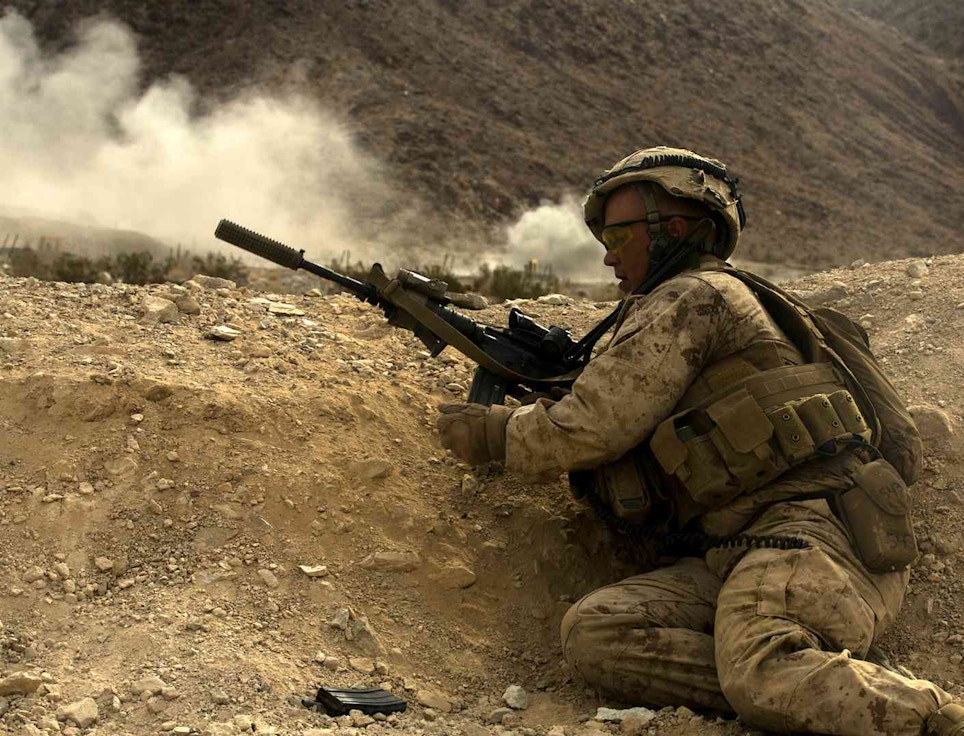
The Marine Corps has been working on a requirement for small arms suppressors since 2016. The so-called “Sea Dragon 2025” exercise was a watershed event in determining the future of Marine Infantry.
After several years of studies and experimentation, the U.S. Marine Corps has issued a letter of intent to purchase an unspecified quantity of NT-4 weapon suppressors from Knights Armament Company for use with the 5.56mm NATO M27 Infantry Automatic Rifles (IAR), M4 Carbines and M4A1 Close Quarter Battle Weapons.
This is the first U.S. Service to field weapon suppressors for their infantry. While Special Operations Forces have long used suppressors for specialized applications, even they have only used them as standard issue since United States Special Operations Command first adopted the Knights NT-4 in the late 90s. This means that up to now, only the elite units from each military service, like the SEALs and Rangers, have had them.
The Marine Corps has been working on a requirement for small arms suppressors since 2016. The so-called “Sea Dragon 2025” exercise was a watershed event in determining the future of Marine Infantry. During this event, the service experimented with new equipment and organizational structure. Lessons learned there are now being applied to the Fleet, including the use of suppressors.
The Marines initially used some of SOCOM’s old NT-4 suppressors to learn about how they would employ them and what attributes to look for. Later, they examined multiple commercially available suppressors, but ultimately ended up where they started.
About the KAC NT-4
The KAC NT-4 is a quick-detach design that works in conjunction with a version of the M-16 flash hider with a notch cut out. The suppressor is put onto the muzzle and twisted into place via the gate latch. Swapping out flash suppressors is the only modification required to adopt the NT-4 suppressor.
The distinctive suppressor with its cooling divots is 6.5 inches long and 17 ounces, so it will definitely add to the length and heft of the rifle. Conversely, it boasts a service life in excess of 10,000 rounds, so they’re getting their money’s worth despite the added weight and length.
Although many would consider the NT-4 to be old technology, the Marine Corps’ analysis showed that they could continue to use their existing bayonets, as well as their existing Small Arms Collimators (SAC), Laser Boresights (LBS), and Blank Firing Adapters (BFA), all of which are critical to accuracy and lethality in both training and combat and are interoperable with their selected small arms suppressor. That too saves some money.
Plus, it already has a National Stock Number (1005-01-437-0324), which was issued by U.S. Special Operations Command. Despite being around since 1998, it’s a workhorse, currently in use with loads of federal and local law enforcement agencies. Plus, it has already been successfully fielded on the M38 Squad Designated Marksman Rifle, which is an M27 IAR fitted with an optic for more accurate fire.
Smaller Signature
Operationally, Marines will have a smaller battlefield signature with the suppressor’s lower noise and flash. Additionally, command and control will be easier, as team leaders won’t have to shout as loud over the sounds of friendly small arms fire. Finally, the deadened sounds will be better for the Marines’ hearing.
While the initial paperwork does not specify a number of new Small Arms Suppressors to be purchased, we do know that the Marines already have a significant number on hand that have been used over the past few years for unit evaluations. These were issued to the Marines from Joint Operational Stocks and preciously used by Special Operations Forces. Essentially, they got them for free, but the number isn’t great enough to fulfill their total requirement. Consequently, they’re buying more.
However, the Marines only currently plan to field these suppressors to their close combat forces. This includes their infantry, select engineers and corpsmen, and Force Reconnaissance. That puts the total number below 30,000.
Suppressors aren’t the only items being used to retool the Marine Rifle Squad. We’ve already mentioned the M27 Infantry Automatic Rifle that is now the standard infantry rifle. The M27 is a version of the commercial HK416 and built by German manufacturer Heckler & Koch. Initially adopted in 2012 as a more compact, lighter-weight replacement for the belt-fed squad automatic weapon, it will now equip all Marine Infantry.
However, one member of each squad will be equipped with the aforementioned M38. The old 40mm Grenade launcher is being replaced with a new version, also by manufacturer H&K. The M320 grenade launcher accepts longer rounds. Squads will also get the 84mm Carl Gustaf recoilless rifle, which fires rockets.
The Marines also are fielding new binocular night-vision goggles. The service has purchased only enough for the infantry and those who accompany them on the objective.
About the Squad
And then there’s the structure of the squad. It’s long been larger than its Army counterpart at 13 members, but recently the Corps expanded it to 15 members, a size determined during the Sea Dragon exercise. One addition is a squad systems operator who operates the Instant Eye quad copter, a camera-equipped small unmanned aerial system that can give the squad a glimpse over the next hill.
More upgrades are coming. Eventually, every M27 IAR will sport a variable-power, telescopic optic. The Marines also are working on new hearing protection systems that not only protect from high noise but also enhance low-level noises, as well as new helmets for the infantry and even jungle boots and uniforms.
These upgrades will result in a more lethal Marine Corps, a service we’ll rely on even more in the future as the great power struggle moves to the Pacific.





